October 5. GONDER TO LALIBELA Our flight to Lalibela was around 11:00 so we had plenty of time to sort out a cab in the morning. We ended up going with one arranged through our little friend in the purple shirt. The airport at Gonder looked pretty new and we had plenty of time to check in out since our flight was delayed. Ethiopian Air came around and served drinks and snacks to compensate for the delay. There was a souvenir kiosk in the waiting area where we bought some stamps and mailed postcards. The man who ran the kiosk was friendly and chatty,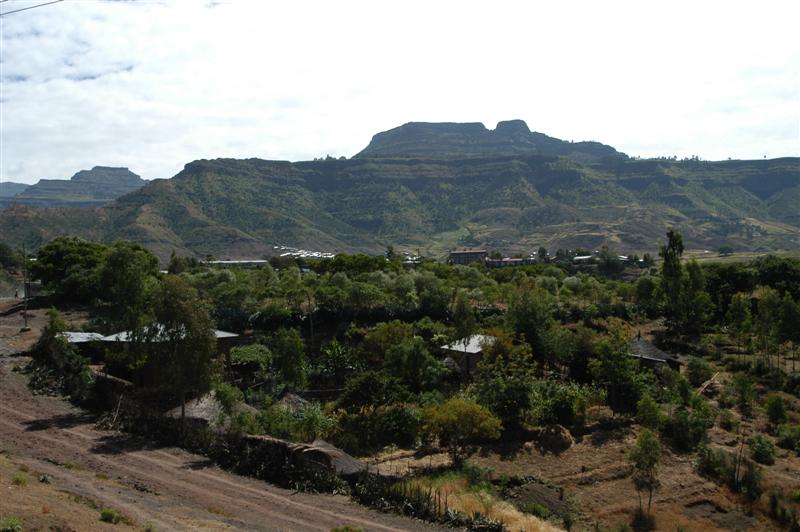 offering us candies as we filled out our postcards. Once our flight finally took off we were only in the air for about 40 minutes before landing in Lalibela. offering us candies as we filled out our postcards. Once our flight finally took off we were only in the air for about 40 minutes before landing in Lalibela.
The Lalibela airport stood some 23 kilometers away from the actual town but there were plenty of vans pooled up to transport people. We ended up in a van with an American man and a couple from Canada; the man was of Ethiopian origin. They were all enthralled with the country so we tried not to dampen anyone's enthusiasm. So far our experience in Ethiopia had been rather mixed. The country had some fascinating historical sites but our encounters with people had ranged from some of the nicest to some of the least nice people we'd met in Africa. Lalibela was known for more hassles than other parts of the country, due to the steady flow of tourists, so we were already planning to shorten our five day stay. The road to Lalibela was well-paved and I was again grateful that we had decided to fly instead of taking buses. The German guy we'd met in Bahar Dar said it took his bus three hours to go the last 60 kilometers into Lalibela.
The surrounding countryside was beautiful. The road wound its way up the hills, along a wide green valley. The American guy commented that the Grand Canyon couldn't match the beauty of this canyon. Technically I am not sure it was a canyon but it was lovely. We came upon a cave church that was nestled under a cliff off in the distance. The van stopped briefly for us to take a look. When the van passed a handful of traditional homes our fellow passengers "oohed and ahhed" over their charming characteristics and expressed their desire for people to keep living in this 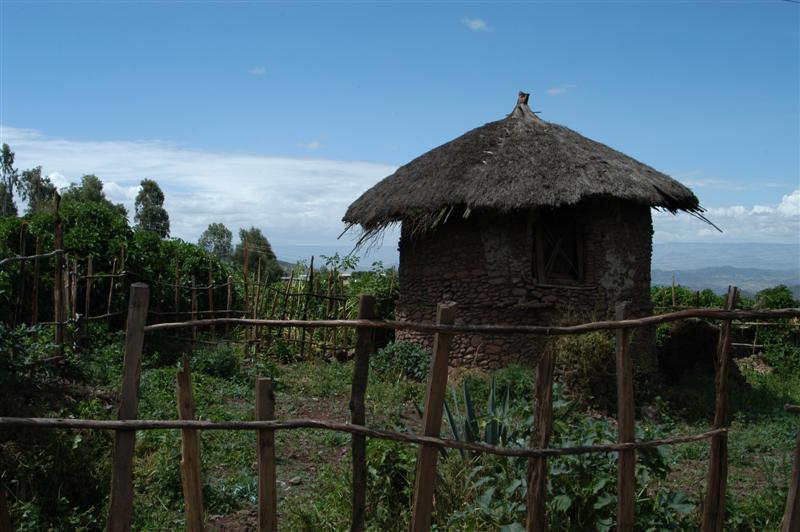 traditional manner. It traditional manner. It 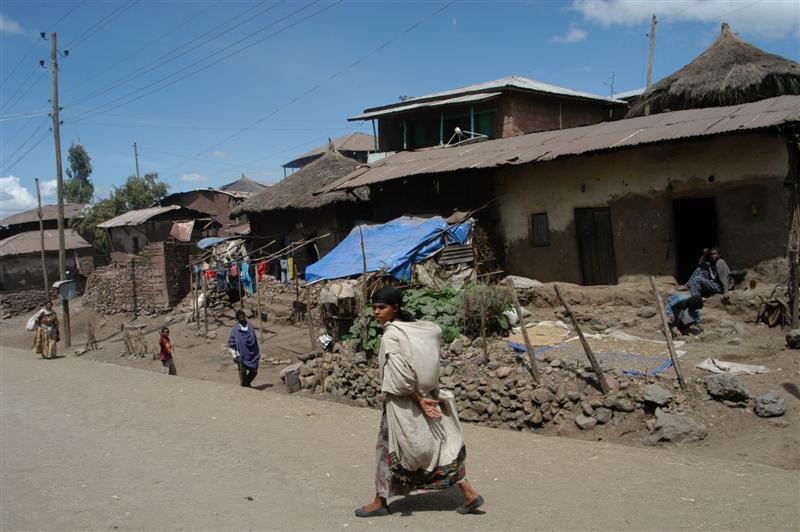 wasn't the first time I'd heard people make such naive comments about life in developing countries but they had grown to really irritate me. While people should be given a choice of how to develop their lives, is it really fair to expect them to stay living without any modern conveniences just because some tourists like the idea of preserving their "traditional" way of life? It is like making a museum out of a group of living people. I felt like asking if anyone in the van wanted to go back to outdoor toilets and no running water, but I didn't. wasn't the first time I'd heard people make such naive comments about life in developing countries but they had grown to really irritate me. While people should be given a choice of how to develop their lives, is it really fair to expect them to stay living without any modern conveniences just because some tourists like the idea of preserving their "traditional" way of life? It is like making a museum out of a group of living people. I felt like asking if anyone in the van wanted to go back to outdoor toilets and no running water, but I didn't.
When we finally arrived in Lalibela we felt like we had taken a step back in time. Standing at 2630m it wasn't much more than a large village. The roads were all unpaved and there wasn't a building over two stories in sight. We let the van take us to the first lodging option we wanted to check out, the Ashton Hotel, but found the prices inflated and figured the van was getting a kick back. As we walked away they dropped the price but we had lost interest. To call it a hotel was rather generous anyway. We set off on foot with our backpacks in search of another nearby hotel, the Blue Lal. The guidebook said that it was "planned" but it turned out to still be under construction. We immediately picked up a throng of touts, all with an interest in helping us find a place to stay. They were persistent and annoying. The Ethiopian Air office was nearby so we went to check into changing our flight from Lalibela to Axum. It was closed for lunch. With the touts still in tow we stopped at small cafe for a soda. One tout, dressed in a bright orange shirt, sat across the way and waited. Rob told him to take off but he said the waitress was his sister. Yeah, right. When the  Ethiopian Air office finally Ethiopian Air office finally  opened we were the first inside. The phone lines had apparently been down for days so they guy would have to radio our change request over to another office and we would have to come back the following afternoon to see what they could do. opened we were the first inside. The phone lines had apparently been down for days so they guy would have to radio our change request over to another office and we would have to come back the following afternoon to see what they could do.
Leaving the Ethiopian Air office I noticed the conspicuous "orange shirt" talking to an older man in a sweater. Orange shirt disappeared but predictably enough "sweater guy" started to follow us. He thought he was being clever by walking ahead of us and casually standing along the road that went uphill towards the Seven Olives Hotel, a government run hotel. We had considered checking rooms there but changed our plans and headed downhill, into the center of Lalibela. When sweater guy looked over the stone wall from his position we waived "good-bye". The road was fairly steep and ran right alongside the entrance to the famous stone churches. Lalibela has been dubbed Africa's Petra because of the stone churches that were carved out of the earth back in the 12th and 13th centuries, when Lalibela was capital of the Zagwe Dynasty. Originally called Roha, the town was renamed Lalibela after the death of King Lalibela, under whose rule the churches were created or at least started. The churches were probably created over a much longer span of time than Lalibela's reign. It is thought that Lalibela sought refuge from his half-brother and went to Jerusalem, returning with the idea of creating his own holy city. Local names like River Jordan and Tomb of Adam give some credibility to this idea.
We couldn't see the churches from the road but noted the entrance as we walked past. The road was being built out in cobblestones and, combined with the nearby tukuls, gave Lalibela an even more medieval appearance. There weren't any 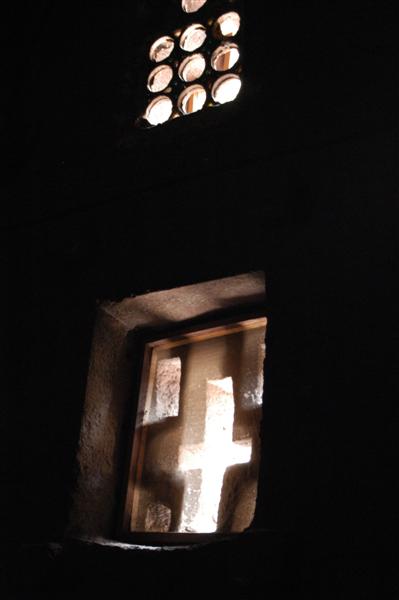 lodging options in the center of town that were wanted to check out and the walk to the next cluster of hotels was farther than we expected. It was all down hill but as soon as we passed the entrance to the churches we picked up more touts. They wouldn't go away and kept tracking us from a distance. We stopped and set our bags down, they stopped and just waited. Rob waived them away and they smiled. Rob finally made some steps in their direction and they began to scatter, thinking the whole situation was pretty funny. It wasn't a good day unless they could bring some tourists to be the brink of insanity. And, adding to our overall feeling of being unwelcome we saw an older man standing up the hill, tending to his crop, who was also laughing at us. We just stood and talked to ourselves for a while to wait out the situation. Finally the tout shuffled out of sight. It wasn't much farther to the Alif Paradise Hotel where we found a small but neat room at a reasonable price. lodging options in the center of town that were wanted to check out and the walk to the next cluster of hotels was farther than we expected. It was all down hill but as soon as we passed the entrance to the churches we picked up more touts. They wouldn't go away and kept tracking us from a distance. We stopped and set our bags down, they stopped and just waited. Rob waived them away and they smiled. Rob finally made some steps in their direction and they began to scatter, thinking the whole situation was pretty funny. It wasn't a good day unless they could bring some tourists to be the brink of insanity. And, adding to our overall feeling of being unwelcome we saw an older man standing up the hill, tending to his crop, who was also laughing at us. We just stood and talked to ourselves for a while to wait out the situation. Finally the tout shuffled out of sight. It wasn't much farther to the Alif Paradise Hotel where we found a small but neat room at a reasonable price.
With our bags unloaded we ventured out to find some food and make arrangements to visit the monasteries. We were thinking about visiting some of the monasteries outside of town but hiring a car through the tourist office was rather expensive and nobody had any incentive to help you hook up with other tourists to share the costs. We made a brief stop at a small cafe just down the street from our hotel but after ordering a couple of coffees we found ourselves totally bombarded with flies. As we walked around they had already started to annoy us but sitting outside in one place was just more than our patience could take. In general, flies were abundant in Ethiopia but Lalibela was the most rural place we had been, with more donkeys and animals aroun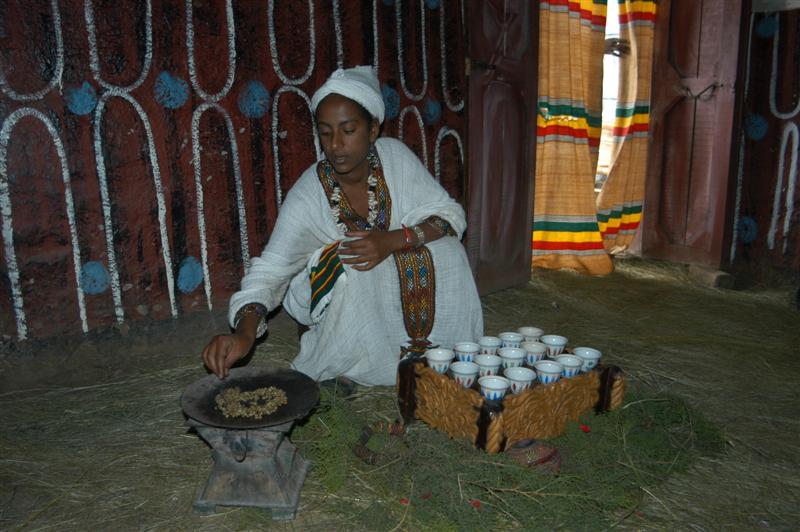 d to attract the flies. We finished our drinks quickly and headed farther down the street to the Hotel Roha, a incongruously modern structure that catered to tour groups. It was government owned, which was unfortunate. I think it is better to patronize locally owned business whenever possible but we were exhausted and longed for the comfortable environment and familiar food that a tourist hotel provided. The had a snack and enjoyed the calm of the hotel lobby. CNN was on TV and there were far fewer flies! d to attract the flies. We finished our drinks quickly and headed farther down the street to the Hotel Roha, a incongruously modern structure that catered to tour groups. It was government owned, which was unfortunate. I think it is better to patronize locally owned business whenever possible but we were exhausted and longed for the comfortable environment and familiar food that a tourist hotel provided. The had a snack and enjoyed the calm of the hotel lobby. CNN was on TV and there were far fewer flies!
With some rest and food we felt ready to see more of Lalibela. We hiked back up the hill to the church entrance. Without our backpacks on we attracted fewer touts but they still emerged to offer guide services or sell souvenirs. One young guy was caught off guard as we came around the corner but still couldn't resist a hearty "Welcome to Lalibela!" as he finished peeing into a ditch. The nicer people also started to become more visible. Without the distraction of touts you noticed the odd smile or nod. We went ahead and bought our tickets to the churches, since it was good for three days of sightseeing, and decided to get started. There were a total of eleven churches inside Lalibela, divided into northern and eastern western groups. We started in the northern group. There were guides available at  the gate but we opted to just look around on our own since it was already late in the day. We would be back to take a closer look the following day and would get a guide then. the gate but we opted to just look around on our own since it was already late in the day. We would be back to take a closer look the following day and would get a guide then.
Once the churches started to come into view it was an awesome sight. The metal rooftops that had been erected to protect them were somewhat detracting but the sheer size of these structures was surprising. It was almost unimaginable to think they were carved completely out of rock. These weren't caves or buildings carved into the side of a mountain, they were totally free standing rock structures. Who built the churches is still somewhat of a mystery but scholars have estimated that it would have taken 40,000 people to construct them all. Ethiopian legend attributes the miraculous speed with which they were built to celestial assistance. Perhaps not quite the mystery that they pyramids were but still a mind boggling achievement. After an area was marked out, construction would have started with trenches being dug out on all four sides. These go as deep as three stories. Then the solid cube of rock would have been chiseled out into a hollow structure. The roofs came up to ground level and stairs lead down to the entrances.
We started our tour with Bet Medhane Alem, said to be the largest rock-hewn church in the world. A tour group was just entering so we took off our shoes and followed quietly. A guard stood at the entrance. We charged him with keeping an eye on our shoes. We had to pay to enter the church area but locals didn't. The interior was cavernous, measuring 33.5 meters long and 23.5  meters wide, and had been hollowed out with a chisel! The building was supported by 72 pillars, 34 on the outside and 38 on the inside. The barrel-vaulted room was lit with fluorescent lights but small cross-shaped windows let in small amounts of natural light. We stood to the back while the tour group went through their little lecture. A priest was in attendance and brought out the famous Lalibela cross, a solid gold 7 kg cross ornately designed in a style that was unique to Lalibela. The priest was kind enough to pose for a photo after the tour group left and we left an appropriate tip to show our appreciation. He was patient as we walked around to look at the three empty graves that stood to the left of the altar, symbolic graves of Abraham, Isaac and Jacob. The lights started to flick off and the priest finally motioned that he had to leave to perform a ceremony. meters wide, and had been hollowed out with a chisel! The building was supported by 72 pillars, 34 on the outside and 38 on the inside. The barrel-vaulted room was lit with fluorescent lights but small cross-shaped windows let in small amounts of natural light. We stood to the back while the tour group went through their little lecture. A priest was in attendance and brought out the famous Lalibela cross, a solid gold 7 kg cross ornately designed in a style that was unique to Lalibela. The priest was kind enough to pose for a photo after the tour group left and we left an appropriate tip to show our appreciation. He was patient as we walked around to look at the three empty graves that stood to the left of the altar, symbolic graves of Abraham, Isaac and Jacob. The lights started to flick off and the priest finally motioned that he had to leave to perform a ceremony.
From Bet Medhane Alem a narrow tunnel led directly to the courtyard of Met Maryam. The tour group had already started into the next church so we stopped in the courtyard and took a rest. Two small children came over and sat next to us, pulling out their school books to show us their work. The security guard saw them and waived them off. It turned out that they were his children and they had come to bring his dinner. Small caves were carved into the surrounding walls and sheet  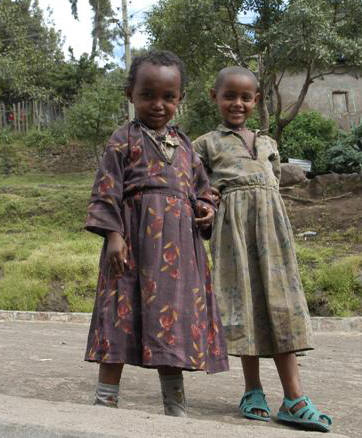 metal covered a couple of them. He reached inside one and put away his meal. They looked like little cubby holes where the guards could rest when off duty. We stopped our tour in the courtyard, leaving the rest for later. We were too tired and didn't want to being tagging along behind a tour group. What little bits of info you could sometimes glean from a tour group were offset by the noise and general loss of atmosphere. It had been a long day so we went for dinner at the Hotel Roha and then back to our hotel to sleep. metal covered a couple of them. He reached inside one and put away his meal. They looked like little cubby holes where the guards could rest when off duty. We stopped our tour in the courtyard, leaving the rest for later. We were too tired and didn't want to being tagging along behind a tour group. What little bits of info you could sometimes glean from a tour group were offset by the noise and general loss of atmosphere. It had been a long day so we went for dinner at the Hotel Roha and then back to our hotel to sleep. |

